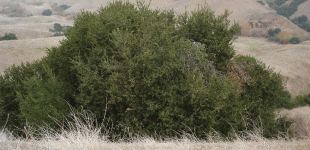 COAST LIVE OAK (Quercus agrifolia)
COAST LIVE OAK (Quercus agrifolia)
Chino Hills State Park is home to a grand oak species known as the coast live oak. Coast live oak is a native, drought-resistant, evergreen tree, ranging in height from 19 to 82 feet and in diameter, at its trunk, from one to four feet. It is referred to as a “live” oak because it is non-deciduousand keeps its leaves all year long; so even in the winter time it looks “alive” as evident with this oak in the middle of a dried out non-native grassland. Coast live oaks have one of the longest life spans of any trees in the Park. There are some trees in the Park that are over 200 years old.
Coast live oak trees are often a welcome sight along trails since they provide shade, which in the Park is sometimes hard to find during the hot summer months. This oak along the Upper Aliso Trail, is especially welcome since it provides shelter to Park users on a portion of the trail. Even more important than offering shade for people, are the benefits the oaks provide for animal life. Oak woodland vegetation is important for animal cover and provide many nesting sites for birds, and shelter for numerous mammals.
The numerous tree branches and snags provide excellent roosts for raptors, provide nesting cavities for owls, kestrels, woodpeckers, nuthatches, wrens, chickadees, and bluebirds. The oaks also support numerous insects and small mammals that are important food sources for other vertebrates in the area. Fallen tree limbs become homes for many invertebrates that are important food sources for numerous vertebrate species including mice, lizards, snakes, and birds. Environmental conditions are aided by the woodland vegetation, reducing wind, and temperature variation compared to grassland and coastal scrub communities.
 SYCAMORE (Platanus racemosa)
SYCAMORE (Platanus racemosa)
Another tree species you will see a lot of in the Park is the sycamore. Known as “Aliso” in Spanish, Park visitors will see a lot of sycamore trees in CHSP’s Aliso Canyon. These trees are easily viewed from Bane Canyon road, along the Chino Hills entrance to the Park. Interestingly the sycamore is one of North America’s largest native broad leaf trees. Unlike other trees, the sycamore tends to grow as scattered individual trees, rather than in a more common cluster of trees. Often times this tree will have its main trunk divided into several secondary trunks with varying directions. This sun loving tree has bark that contains a variety of shades of grey, green, white, tans, and sometimes yellows. Sycamore leaves are are very large, often times over seven inches in diameter. These trees can live between 250 and 600 years!
It is fairly common to see a sycamore tree with a hollow portion of its trunk. Sometimes these hollow areas make the tree susceptible to the elements, but they sure provide a great place for birds, like great horned owls, to call home. Park visitors will see a lot of sycamore trees when using the Chino Hills entrance to the Park. In addition to the hollow trunk, this tree sheds portions of its outer bark, which flakes off in large chunks. Its large overhanging branches make superb nesting sites for a variety of birds. In addition, the tall trees offer good viewing spots for birds of prey to catch their next meal.
Sycamores tend to grow on flat lands, flood plains or in streams. Quite a few sycamores in the Park are found in Aliso Creek and other parts of the Park like Telegraph Canyon. Though its wood isn’t considered a good wood to build with, Native Americans used sycamore wood to make bowls and other cooking utensils.
 TECATE CYPRESS (Cupressus guadalupensis)
TECATE CYPRESS (Cupressus guadalupensis)
With only twenty stands of tecate cypress found worldwide, this unique tree is one of Chino Hills State Park’s most prized plants. Found only in southern California and Mexico, there are only eight stands of this tree found in the U.S. — all of which are in Southern California. Tecate cypress trees range has decreased due to fire and change in climate. It is normally only found in a few scattered stands. One of the those stands happens to be the southern most portion of the State Park, near the Department of Fish and Game’s Tecate Cypress Preserve and the Cleveland National Forest in the Santa Ana Mountains. This tree is only found in elevations ranging from 1400 feet to just over 3000 feet.
This evergreen tree varies in height, normally reaching a maximum of 32 feet tall with dark green foliage. Its leaves look like small scales and it produces cones that open after fire. Unfortunately the State Park’s stand has seen an increase in the frequency of fire. Normally the trees benefit from fire every 50-60 years. However, in recent years they have endured more frequent fires. Once the cone opens the seeds disperse and new colonization begins by the tree.
For Orange County’s tecate cypress stand, the northern most range of the tree, they are found in Gypsum, Coal, and Fremont Canyons. Like other plants found in Southern California, the tecate cypress also does well in chaparral ecosystems with dry slopes. Due to its rarity, it is listed as a special species by the Bureau of Land Management and the California Native Plant Society.
 BLACK WALNUT (Juglans californica)
BLACK WALNUT (Juglans californica)
Chino Hills State Park has some of the southern most stands of the California Black Walnut. This particular tree is deciduous and medium in size. It tends to grow on the coastal and inland foothill slopes. It is a member of the southern oak woodland community and grows very quickly up to 20 feet tall and 20 feet wide.
The walnut tree tends to have attractive leaves in the fall, which change colors with the seasons. It is also highly adapted in terms of where it can grow — it thrives in poor soils. The walnut tree provides important habitat and foraging opportunities for wildlife. Squirrels and other small animals thrive on the walnuts dropped by the tree.
Unfortunately this tree is threatened by development in Southern California. This makes the stands left in the area and protected in the Park that much more important.
